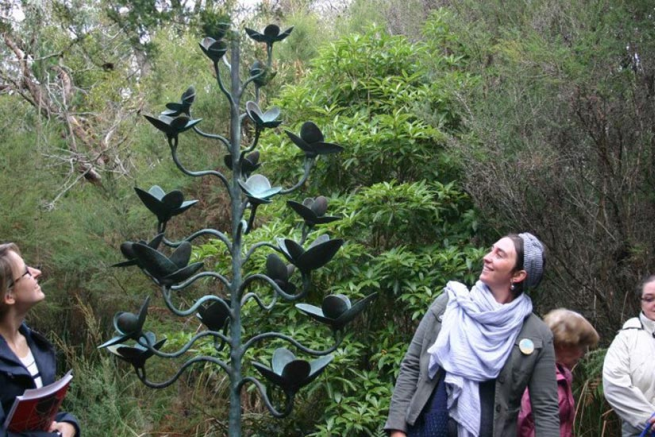McClelland Sculpture Survey & Award 2012

Artist Statement
Memorial to all that is Good in this World is my tribute to Nature – the landscape, plants, animals, minerals, and the forces of nature that arranges and adapts all of these elements for life on earth.
In my work I arrange and present natural forms, such as the tree and the honey-bee, as an analogy for life itself. Imbued with mythic qualities, they generate narratives about life and death and the interplay between humanity and the natural world. Here, the tree is inscribed with the memories of those that once lived in a wild landscape abundant with flowers, bees and animals, each with their own unique relationship to one another.
It is a commemoration derived from ancestral memory (kith and kin) both collective and individual, and from an imagined perspective regarding the power and influence of the natural world and the great sacrifices it has made for humanity.
At the core of my work is a desire to better understand and remember the beneficial connections that exist between humans and other life forms, with the hope that it will (re-) generate a deeper appreciation and respect for the natural world.
I live in the Central Victorian Goldfields and often create sculptures that are informed by what can be found in this area, such as the wildlife, bush and sky – scapes, trees and waterholes. The idea for Memorial first came out of an observation of the numerous stone cairns and bronze plaques celebrating the expeditions and discoveries of Europeans across the landscape, without a single mention of the flora, fauna or indigenous people that were displaced or made extinct as a result of settlement. I set out to rectify this with a Memorial to Nature, with specific reference to threatened species of the area. I have a vision of seeing them throughout the country, placed close to the heart of the community like a war memorial or town landmark!
As an ardent admirer of world heritage culture and environments, my work also reflects the aesthetic of Indigenous, Etruscan, Egyptian, Classical & Japanese art styles (to name but a few!) that have also influenced the many artists that I study & admire such as Giacometti, Wolsley, Bourgeois or Hunderwasser. The state of the world’s environment has always been a concern for expression in my artwork, particularly our tenuous relationship with Nature, giving me inspiration to create art as a kind of bridge to an experience of being with the natural world.
About the McClelland Sculpture Survey
Since its inception in 2003, the McClelland Sculpture Survey has emerged as the most important outdoor sculpture exhibition in Australia, displaying a wide range of works in different media and styles by both established and emerging artists. Displayed throughout 16 hectares of bush and landscaped gardens, the McClelland Sculpture Survey is intended to provide sculptors the opportunity to present their works in an outdoor exhibition context. The exhibition is accompanied by a major comprehensive catalogue.
The McClelland Sculpture Survey & Award 2012 is presented in equal partnership by the Elisabeth Murdoch Sculpture Foundation and The Balnaves Foundation.
The animals and plants inscribed on the piece are mostly listed as threatened and endangered in the Central Victorian area and in the oceans of the world. There are also those animals and elements that I just have a special affection for.
- Green sea turtle
- Blue Whale
- Regent Honeyeater
- Pink – tailed worm lizard
- Eltham Copper butterfly and Sweet Bursaria bush with ants of the genus Notoncus – the special relationship between the two insect groups and the Bursaria is the key to the butterflies’ survival
- Bush Stone – Curlew
- Bees and honeycomb
- Spiny Rice flower
- The rivers, oceans and streams
- The earth and rocks (Jamieson River spiral rocks)
- Scar trees and banksia



